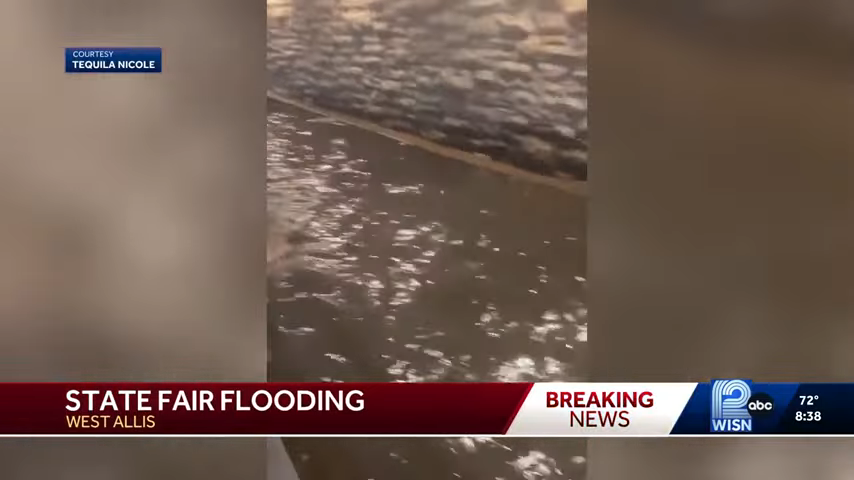In a matter of hours, the 2025 Wisconsin State Fair came to an abrupt end. What was meant to be a celebration of agriculture, culture, and community turned into a scene of chaos as severe flash flooding hit Milwaukee and surrounding areas.
Flash Floods: The Storm That Took Everyone by Surprise
The flash floods that swept through southeastern Wisconsin weren’t just powerful—they were unexpected. With reports of up to 10 inches of rain falling overnight, the storm overwhelmed both the infrastructure and the people. Local officials had issued warnings, but the speed and intensity of the storm were simply too much.
As the rain poured down, the Menomonee River, which runs through Wauwatosa, overflowed, flooding streets and homes. Cars were left stranded, while residents, some of whom were wading through knee-deep water, scrambled to salvage what they could. The flash floods turned calm neighborhoods into raging rivers, leaving a path of destruction behind.
The Wisconsin State Fair Cancels Its Final Day
For the thousands of fairgoers who had come to the Wisconsin State Fair, the news of its closure was devastating. After torrential rains flooded the grounds in West Allis, event organizers had no choice but to cancel the final day of the fair. This cancellation wasn’t just a logistical issue; it was a stark reminder of how vulnerable the state is to extreme weather events.
The fairground, usually bustling with activity and excitement, was now submerged. Tents, food stalls, and rides were all overwhelmed by rising waters. It was a disappointing end to what is typically an 11-day celebration of Wisconsin’s agricultural heritage.
Power Struggles and Community Resilience
As the waters receded, the scale of the damage became evident. Many homes were flooded, and cars were left stranded in the middle of streets. In Wauwatosa, residents like Bill Suechting spent the night monitoring the rising waters, hoping they wouldn’t spill over into their homes. “We were up, 2, 3 in the morning, watching the water creep closer,” Suechting said. “We were one of the fortunate ones.”
Thousands of others were not so lucky. With power outages affecting nearly 47,000 homes, the recovery process has been slow and painful. Emergency responders worked tirelessly to rescue residents trapped by the floods. Over 600 calls for help were made, including dozens of water rescues, highlighting just how serious the situation became.
Is Wisconsin Ready for More? The Growing Threat of Climate Change

The events of August 10, 2025, are a stark reminder of the changing climate and the increased risk of extreme weather events. Climate scientists have long warned that the Midwest is particularly vulnerable to these kinds of storms, and this incident only reinforces those concerns.
While Milwaukee was hit hardest, other parts of the region also experienced severe flooding. The increasing frequency of these storms means that communities will need to be more prepared, both in terms of infrastructure and emergency response. The key to future resilience lies in embracing climate change mitigation strategies and investing in flood prevention infrastructure.
The Road to Recovery
Despite the devastation, the people of Wisconsin have shown remarkable resilience. Neighbors helped neighbors, and local volunteers stepped in to assist with cleanup efforts. While the Wisconsin State Fair’s final day was lost, the community’s spirit was not. Now, as the state focuses on recovery, it’s essential to address the underlying issues that allowed this flooding to cause so much damage.
City leaders, including Milwaukee’s Mayor Chevy Johnson, have pledged to focus on improving flood prevention and preparedness. But these changes won’t happen overnight. It will take time, effort, and collaboration to ensure that Wisconsin is better equipped to handle the storms of tomorrow.
Looking Ahead: A Future of Stronger, More Resilient Communities
The 2025 Wisconsin State Fair flooding was a painful event, but it also serves as a powerful reminder of the need for change. It’s a wake-up call to improve flood infrastructure, develop stronger early warning systems, and take climate change seriously. If Wisconsin can learn from this tragedy, it can build a more resilient future for its residents—one where extreme weather doesn’t have to result in such devastating consequences.
Bio Data:
| Name | Bill Suechting |
|---|---|
| Location | Wauwatosa, WI |
| Profession | Local Resident |
| Role in Topic | Survivor and Local Responder |
| Experience | Affected by 2025 Wisconsin State Fair Flooding |
| Notable Event | Witnessed Menomonee River Flood Impact |
| Related Website | Milwaukee Journal Sentinel |
Key Facts:
| Fact | Details |
|---|---|
| Date of Incident | August 10, 2025 |
| Location | Wisconsin State Fair, West Allis, WI |
| Flooding Impact | Flash floods up to 10 inches of rain |
| Power Outages | 47,000 customers without power |
| State of Emergency Declared | Yes, in Milwaukee County |
| Cancelation | Last day of Wisconsin State Fair |
For ongoing recovery efforts and updates, visit The Milwaukee Journal Sentinel.
Conclusion: A Call to Action
The flooding at the Wisconsin State Fair is a reminder that extreme weather events are not isolated incidents. Climate change is making these storms more frequent and severe, and it’s time for Wisconsin—and the Midwest—to take action. By investing in flood protection, better infrastructure, and sustainable practices, Wisconsin can become a model for resilience in the face of an uncertain climate future.
